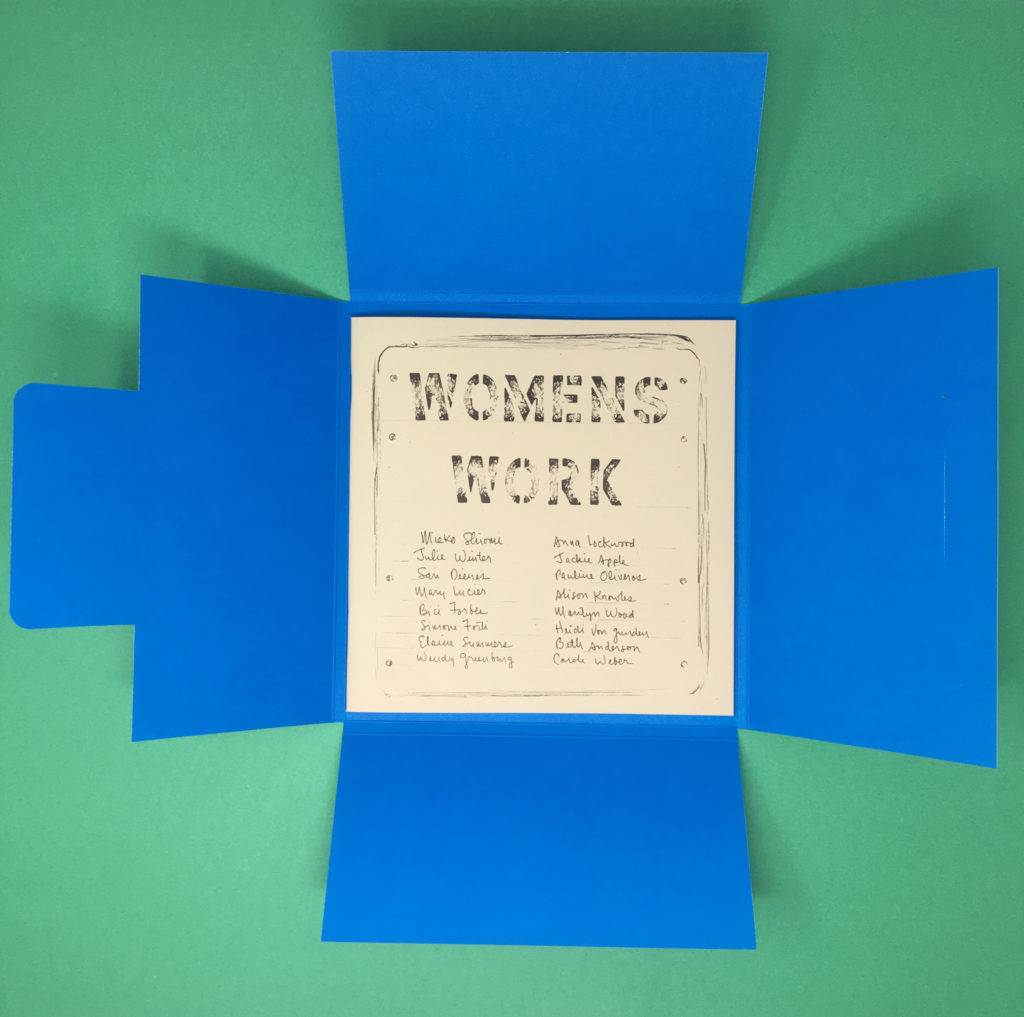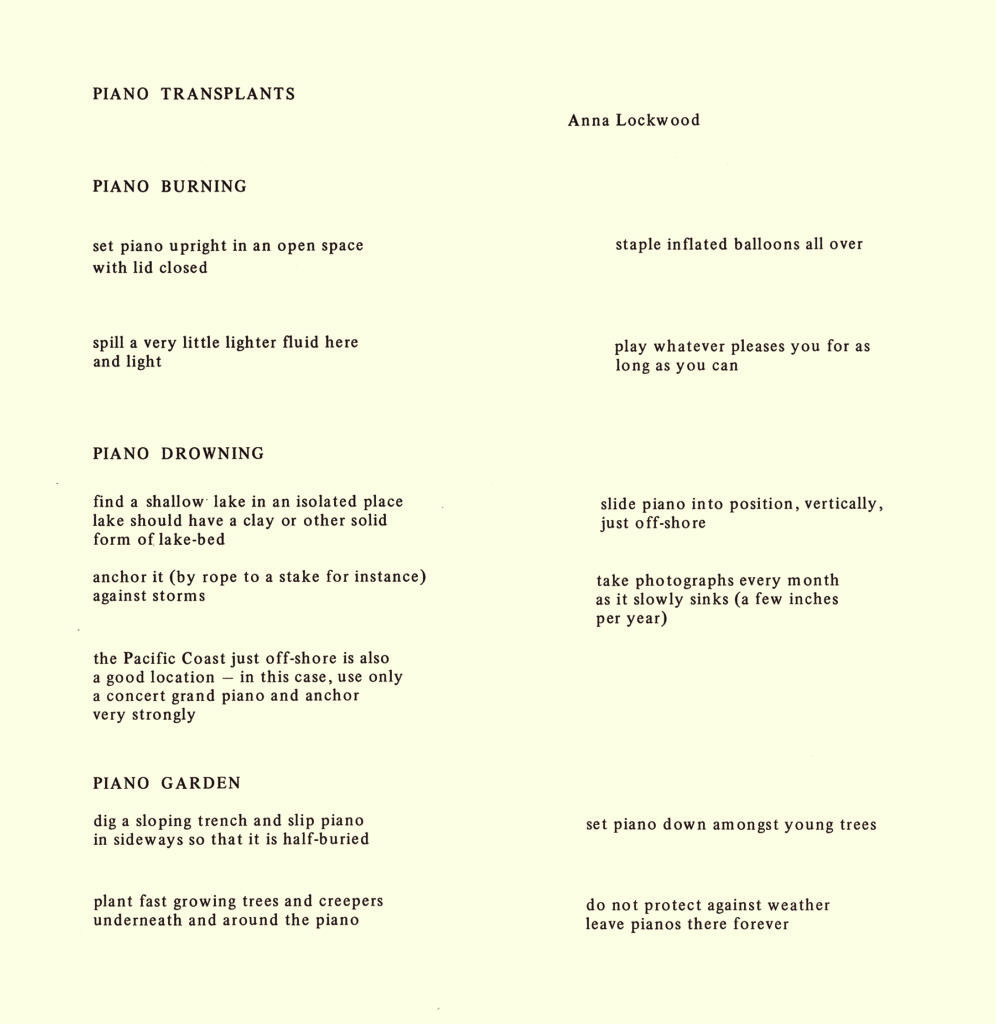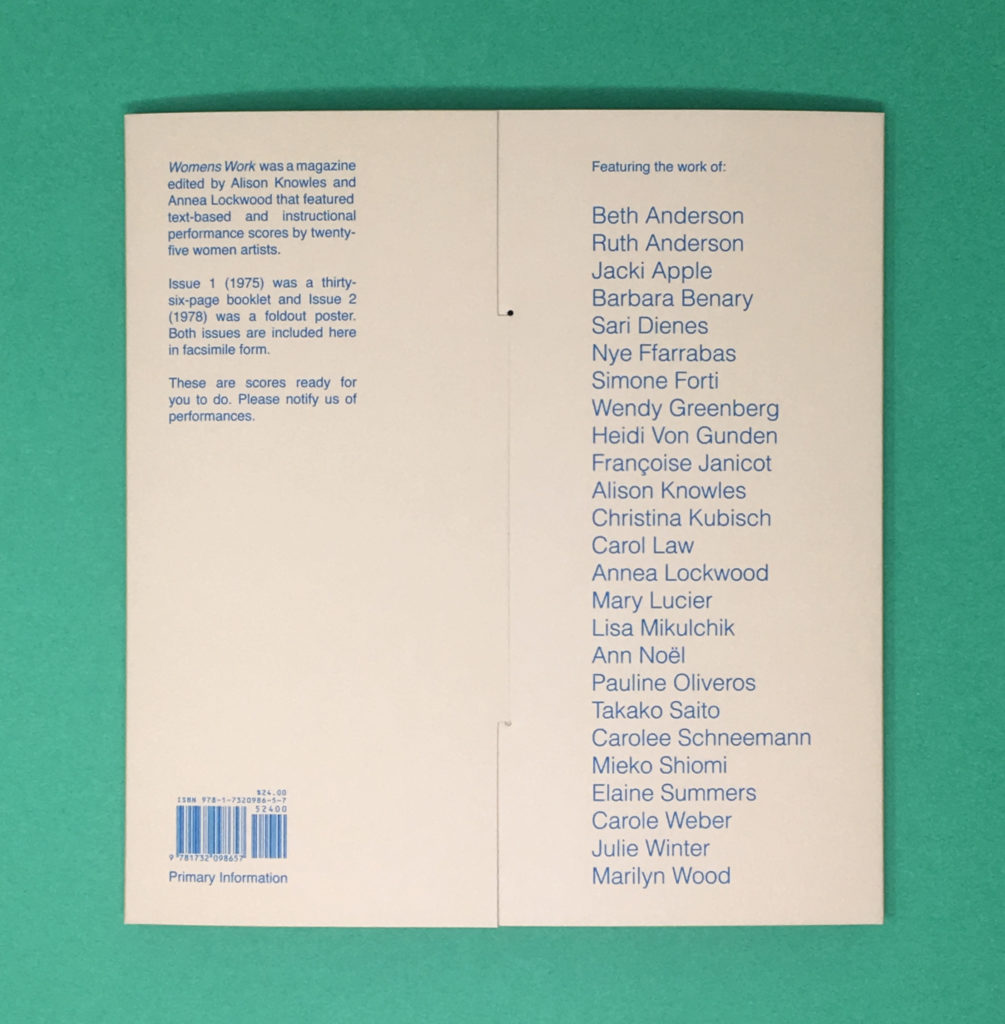Compiled by Annea Lockwood and Alison Knowles and originally published in two volumes in the mid-70’s, Womens Work was the first publication of performance scores exclusively by women, featuring work by Annea, Alison and;
Mieko Shiomi
Mary Lucier
Bici Forbes
Simone Forti
Elaine Summers
Wendy Greenburg
Jackie Apple
Pauline Oliveros
Marilyn Wood
Heidi Von Gunden
Carole Weber
Sari Dienes
Carol Law
Beth Anderson
Anne Williams
Lisa Mikulchik
Ruth Anderson
Carolee Schneemann
Christina Kubisch
Barbara Benary
Takako Saito
Françoise Janicot
On the occasion of its republication in a facsimile edition, Jez riley French gathers recollections…

I came across a few mentions over the years and talked briefly with Annea about ww at a festival in 2011, but it was when Irene Revell sent me scans of an original copy that I got to see it fully. It was a stark reminder of how, even with a long, detailed interest in a field, there are often layers of distortion across the surface of art history. This re-printing is a further stripping away of the dust of stale patriarchy.
I emailed Annea urging a re-print, but my part in this is small. Irene has done so much to bring ww to new audiences and on this new edition. All of us who care about these art forms owe her a lot, as we do of course to Annea, Alison and all of those who contributed scores, and to James, Miriam and all at Primary Information.
Now these works for us to do need to be done, over and over.
constant distortions are audible
as well as visual
– Jez riley French
below are some reflections I collected for this article during May and June 2019;
Annea Lockwood
JrF: do you remember the reaction to it at the time ?
AL: I think it aroused real interest. I don’t recall people contacting Alison or me about any performances – basically, we were both really busy with our own performing/composing/art work – it was an intense time.
JrF: what is your perception of the importance of the reprinting now, at this time
AL. l am absolutely delighted, both that those particular works by those artists can once again circulate, be performed and, as it were, live again. ‘These are works for you to do’ – the practical nature of the collection, was very important to us.
JrF: During a recent workshop discussion around the gendering of sound art history some of the participants felt the title ‘Womens Work’ was now somewhat problematic, stating that they have grown up demanding they be referred to as artists / composers rather than female artists / composers. That is a positive sign but, in the context of the time, is it fair to say that using the term ‘Womens Work’ was necessary & perhaps, unfortunately, still is to some degree ?
AL: The gendering/identification of artists as female, (not, I note, as male since that was and often still is the assumed ‘norm’) has been controversial for as far back as I can remember. As a young composer I too wanted simply to be identified as a composer, but as the herstory of women musicians in western music was gradually brought forward by the women’s music movement and the essential work of major feminist musicologists (such as Susan McClary’s ‘Feminine Endings’) I came to recognise that ignoring my gender, sort of neutering myself denied the culturally implicit and obvious gendering of ‘composer’ as male, which has had major effects on access for composing women until recently. I also realised that by accepting that my gender was integral to my composer’s identity, I could help to encourage younger women to assert themselves as composers also. Role models matter. I think that is still true, as I have heard from a number of younger women composers.
JrF: As copies of the reprint find their way into university libraries and a wider consciousness it will be even more visible, even more accessible and part of a growing range of texts and works that provide young artists, especially young women with a more balanced resource when it comes to research.
AL: Ah yes, this is perhaps the greatest benefit of all the generous work which Irene, James, you have done to get WW back into circulation. My whole hearted thanks.

Simone Forti
Blue on beige, open the box slowly, your hands will feel good. You will see names of friends, some still here, others gone. You are still here but will one day be among those who are gone.
Find a likely surface where to leave the opened box. The blue of its inner surfaces enters my eyes so easily. The cardboard flaps remain bent at different angles. The book is just the right size and I read it at one sitting. Each of the women’s entries transports me to a new location. A lake’s edge where the piano sits in water, a college campus where gentle antics leave me lightheaded, a nowhere/everywhere where space is a flat surface ready to receive two gestures. My page pleases me. I still do this “Scramble” in my workshops. It always lights up smiles. We’ve let go of the buzzing.
Catherine Kontz (composer)
I find it fascinating to discover these text scores which very much relate to a way of thinking about sound and performance which is still stimulating today and feels quite current although they were conceived 40 years ago.
Simone Forti’s happening – in very few words, she sets a scene, creates movement and, almost as an afterthought, makes sound happen. In this case, the fact she can say everything essential in one sentence is just beautiful!
Annea Lockwood’s Piano Transplants – As a pianist, I’m always a little uneasy about seeing an instrument destroyed. Equally, I am fascinated by the idea of taking this house-bound instrument out of its normal surroundings and into a more “natural” space…and merging the sounds of the hammers and strings with the living elements of wood, water and fire.
Sarah Hughes (artist)
For me, the performance of these scores is in the becoming aware of a situation, the call back, the insert into the everyday, the creation of an outline. You do it by remaining attentive to lived experience.
Wendy Greenberg’s ’The Mark – A Zen Drawing’ reads like I am describing how I approach installation as it relates to composition – familiarising oneself with a space and making work/s in response and the parallel process of articulating sounds in space and translating that to the page, for performance by others.
And of course, these are compositions for performance, to do in real time. Alone, with others, to an audience, in the kitchen, outside, for friends, for passersby.

James Hoff (artist / publisher)
I was always curious about WW and after seeing it, it just made sense to get it out into the world. There is a new generation of artists looking to this era and searching for work that doesn’t correspond to the male-dominated canon. As a publisher, it was a no-brainer and as an artist and reader with an interest in this era, it was a much-need introduction into works and a few artists that I was unfamiliar with.
Irene Revell (curator / artist)
JrF: where did you first come across WW:
IR: I came across Womens Work in an exhibition in MoMA’s archive. I got in touch with Annea and she kindly sent a copy that I then exhibited as part of an exhibition project Slow Runner (Badischer Kunstverein, Karlsruhe, 2013), that I then donated to the Her Noise Archive, as there are very few copies in institutional collections, especially outside of the US. I was really struck by the heterogeneity of practices that the two issues evidenced – from across art, composition and choreography, and beyond. And that it seemed to be consolidating this moment of feminist consciousness amongst these communities of practice in interesting ways, not least through the format of the published score.
JrF: Do you have any thoughts on where these pieces sit in a contemporary setting ?
IR: I mean, scores in general, even traditional musical notation, are mostly written with perhaps some specific performances in mind but also speculating on unspecified futures through performance. Or that’s to say I guess that I think many scores inevitably have a kind of futurity to them. But i also think these specific kinds of textual, instructional scores maybe have garnered a specific interest in this current moment for various reasons. I do think for me there is something very specifically appealing about these kinds of performance scores, that they offer at once these very concrete instructions, ideas, at the same time as being open to future performances and interpretations, sharing forms of authorship in quite precise ways. My friend Aura Satz has spoken about this in terms of being a kind of ‘blueprint’ in these increasingly uncertain times, politically.
JrF: In your interview with Annea you comment on the diversity of practices reflected. Perhaps you could say something about the materiality of shared endeavour ?
IR: “The materiality of shared endeavour” is a lovely expression. I mean in the interview Annea talks about these collaborations that were often occurring, and I think I would say that for me the proposal of Womens Work itself in the invocation that “these are scores ready for you to do” is a suggestion of group situations, social material. Some works may be performed alone, but others require the negotiation of a group in their interpretation and performance. This is what poses interesting questions to me as a curator, how one might convey that materiality, the iterative group situations.
*
(nb. many of the responses were longer than can be included here – the full texts are available here)
*
A limited number of reprinted copies of ‘Womens Work’ are available directly from Jez at £15 inc. p&p (UK) or £18 (EU) – if you’d like a copy you can email him here.